The Iaido Newsletter March 2000
Last article we discussed two different grips on the tsuka while drawing and cutting with the blade. This time we will continue with that discussion and find out that life isn't quite as clear-cut as we may think.
We noted the difference on the nuki tsuke of the "index finger" and the "little finger" grips when we come to the finish of nuki tsuke, the draw and cut. What are the implications of this difference in grip for the rest of the kata? Well it depends, are we talking about a one handed or a two handed cut?
First, let's examine the grip itself.
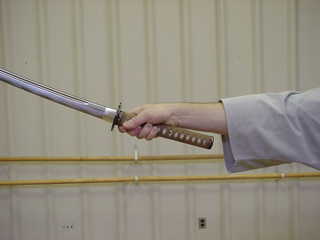 Take
a look at Figure 1 here, and Figure 2 just below. This is the correct grip
for a two handed swing from overhead. It is the same grip as we saw last
article which resulted in a longer reach on the initial cut. Here, however,
with two hands on the blade we get a much more powerful cut. With the hands
at shoulder height as in figure 2, the left thumb touches the underside
of the right wrist. The monouchi (about a third of the way back from the
tip) is at the height of the forehead (of the student or of an opponent
of equal height), and the reach is optimized. Note carefully the fingers
of the right hand in Figure 2, see how the index finger and thumb are not
overlapped. In fact the thumb touches the second finger.
Take
a look at Figure 1 here, and Figure 2 just below. This is the correct grip
for a two handed swing from overhead. It is the same grip as we saw last
article which resulted in a longer reach on the initial cut. Here, however,
with two hands on the blade we get a much more powerful cut. With the hands
at shoulder height as in figure 2, the left thumb touches the underside
of the right wrist. The monouchi (about a third of the way back from the
tip) is at the height of the forehead (of the student or of an opponent
of equal height), and the reach is optimized. Note carefully the fingers
of the right hand in Figure 2, see how the index finger and thumb are not
overlapped. In fact the thumb touches the second finger.
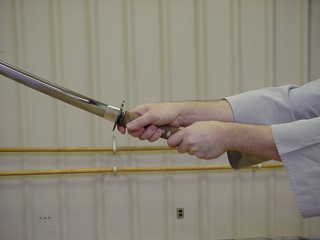
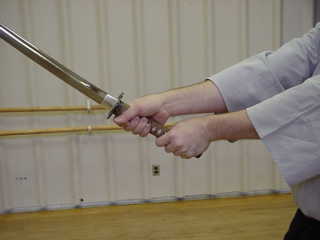 Now
in figure 3 we see the other grip. The index finger overlaps the thumb,
and is used in the grip. See how this changes the angles between the blade
and the forearms, and how it is now impossible to extend the tip forward,
or touch the right thumb to the left wrist without "breaking" the wrists.
This grip is common in beginners, and gives a short, circular shaped chop
as opposed to the lovely elliptical slice we so prize in iai.
Now
in figure 3 we see the other grip. The index finger overlaps the thumb,
and is used in the grip. See how this changes the angles between the blade
and the forearms, and how it is now impossible to extend the tip forward,
or touch the right thumb to the left wrist without "breaking" the wrists.
This grip is common in beginners, and gives a short, circular shaped chop
as opposed to the lovely elliptical slice we so prize in iai.
Once more, the grip must be from the little fingers, those closest to the body, for the grip to be correct.
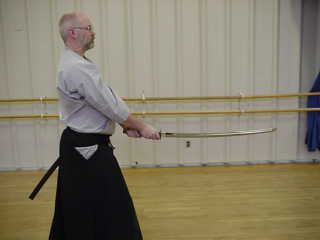
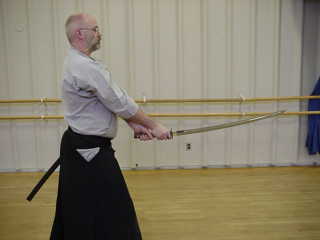
Let's continue the swing down to the horizontal position. Compare figures 4 and 5, in 4 the softer grip with the index fingers allows the blade to move naturally down, while the tension in the index fingers in figure 5 keeps the tip up. It also keeps the shoulders up and the entire blade further forward.

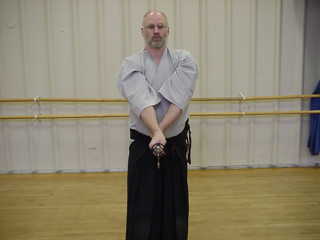
Figures 6 and 7 show the same thing from the front. Notice how the index finger tightness in figure 7 pulls the hands over top of the tsuka, straightening the elbows and raising the shoulders.
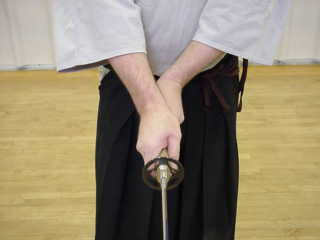
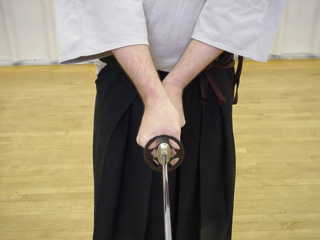
This hand grip is illustrated more clearly here in figures 8 and 9. The "over the top", thumb overlapping index finger grip makes for a stiff, shoulder-driven swing that just doesn't have the grace, smoothness or power of the little finger grip.
But is this grip always the best choice? If you can keep a secret, take a look at the next pair of photographs.
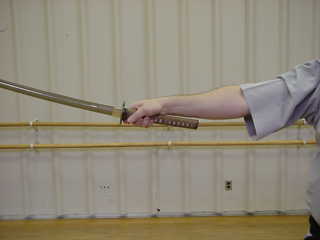 Figure
10 shows a one handed swing of the blade using the little finger grip.
This position may be the end of a "kiri tsuke" movement, a draw into a
downward cut as you would find in the ZNKR iai kata Morote Tsuki. See how
extended the elbow is, and how the tsuka seems in danger of slipping right
up across the hand as the swordsman strains at the elbow to stop the cut.
Figure
10 shows a one handed swing of the blade using the little finger grip.
This position may be the end of a "kiri tsuke" movement, a draw into a
downward cut as you would find in the ZNKR iai kata Morote Tsuki. See how
extended the elbow is, and how the tsuka seems in danger of slipping right
up across the hand as the swordsman strains at the elbow to stop the cut.
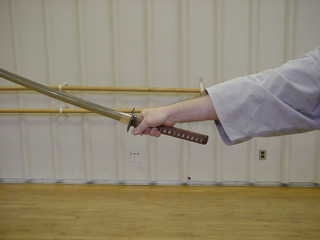
Now take a look at this photo (fig 11), and note how much more powerful
it looks. The blade is firmly gripped in the palm and the tsuka is backed
up by the wrist rather than by the palm.
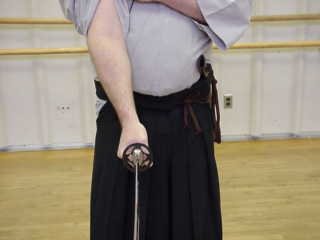

This is more clearly illustrated here in figures 12 and 13. Imagine a line of force moving from the tip of the blade up through the hand. In figure 12 (little finger grip) you can see that the line of force misses the wrist, while the more "over the top" grip of figure 13 means that the blade is lined up with the forearm. On a one handed cut, where you wish to drop the blade down your centreline with power, and where you wish to stop or otherwise control the blade, it is of some considerable advantage to use a more full-fingered grip, and to bend the wrist into the cut. With two hands, the two angles of the hands cancel out and the blade moves down the centreline smoothly using the slightly off-centred little finger grip.
 To
sum up then, for a one handed cut you should take a grip that puts the
tsuka across your palm almost squarely as in figure 14.
To
sum up then, for a one handed cut you should take a grip that puts the
tsuka across your palm almost squarely as in figure 14.
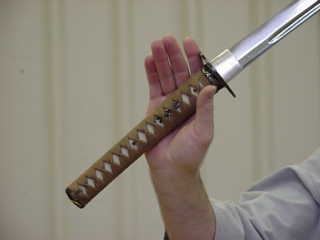 While
for a two handed swing, a grip which puts the tsuka diagonally across the
palm, as in figure 15, is more desireable.
While
for a two handed swing, a grip which puts the tsuka diagonally across the
palm, as in figure 15, is more desireable.
This discussion has covered a lot of ground and introduced some potentially confusing concepts, my advice, as always, is to follow what your instructor is teaching you. This is particularly true of the discussion of the two handed grip. Many instructors (myself included) prefer to teach their beginning students a very square, "over the top" grip for the first few years. This is to correct the very common beginner practice of gripping the sword from the sides.
With long practice and constant correction of the shape of the swing, these students will naturally relax their grips into the more desireable diagonal grip.